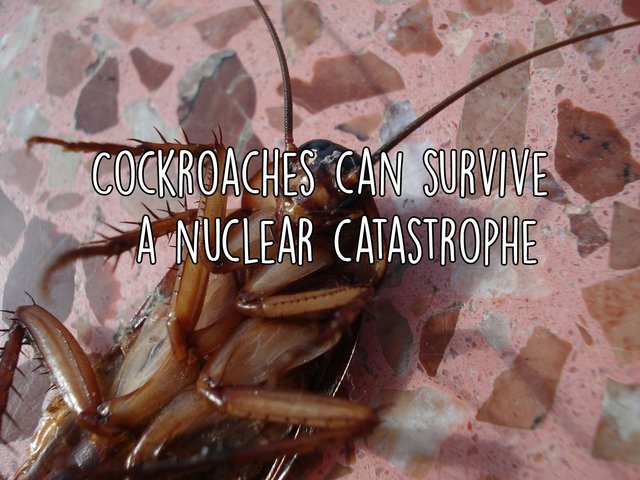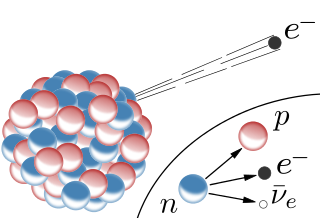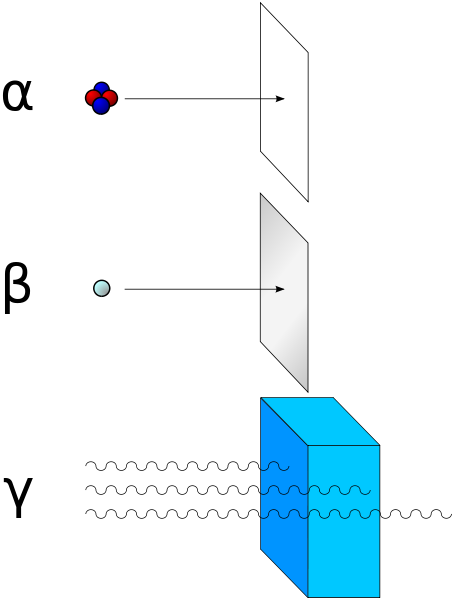Myth or Fact? #17 – Cockroaches can survive a nuclear catastrophe

"Hello dear reader!
My name is Cockroachy, the coolest cockroach in town! I live next to a nuclear-weapon test zone and life is pretty tough here! However I am fine and a survival specialist. We don't understand why humans do destroy their own planet but that's not part of today letter to you."
...this is what my little brother wrote last week as they had to write a story of insects. Don't ask me how he came up with this story but as we all know, kids can be very creative!
Actually I am thankful he came up with this story since it remembered me of an myth I heard. It is said that cockroaches can survive anything, even a nuclear catastrophe. Sounds crazy. Sounds like a myth! Well today we will find out.
Deadly radiation
Before we investigate whether or not cockroaches would survive a nuclear catastrophe we need to understand what radiation is and why it is dangerous. We have different kinds of ionizing radiation.
(If you want to know more about the radio active decay I recommend to read my post radioactive-contaminated-waste-glows-green)
Alpha, beta and gamma decay
The alpha decay is the radiation of helium nuclei, made up of 2 protons and 2 neutrons. Because this particle has no atomic shell it has a positive charge. As we can see in the figure above alpha decay occurs at heavy, unstable nuclei. After the alpha left, the mother nucleus has 4 neutrons and two protons less.

Fig.1 Schematic illustration of the alpha decay. Credits
The beta decay occurs on heavy as well as on light unstable nuclei. Because of the neutron excess, a neutron decays into a proton and electron. The proton stays in the nucleus whereas the electron is emitted. Because the proton has a higher mass it only can decay into a proton and an electron. This ionizing radiation has a negative charge since electrons are emitted. (To be accurate the neutron decays into a proton, electron and electron-antineutrino). The above described decay is also called beta- radiation. There is also a beta+ radiation where positions are emitted (imagine an electron with a positive charge)

Fig.2 Schematic illustration of the beta decay. Credits
The gamma decay itself has no particle emission. In most cases a nucleus is left in an excited state after alpha or beta decay. When this nucleus gets back to a lower state it radiates penetrating, electromagnetic gamma rays. So mostly gamma radiation is observed together with alpha and beta decay.

Fig.3 Schematic illustration of the gamma radiation. Credits
There are ways to shield against the different types of ionizing radiations. Alpha, beta and gamma are named in the order of their ability to penetrate material. Alpha has the lowest range and gamma the highest. To protect against alpha radiation a simple sheet of paper helps. Thin foil of aluminum can be effective against beta radiation and to stop gamma rays plumb is used. Gamma rays are dangerous because they have a high range, however alpha and beta radiation are not to be underestimated since they can have lethal effects on organisms.

Fig.4 Alpha radiation can be blocked with paper, beta with thin aluminum foil and gamma radiation with plumb. Credits
Biological effects of ionizing radiation
The biological effects of ionizing radiation depends on many factors such as the exposed area, the rate of absorption, type of radiation etc.
As we saw above, ionizing radiation changes the physical and chemical properties of atoms. This has some serious consequences since our molecules are build of atoms, cells are build of molecules and our body is build of cells. Radiation can affect the whole organism!
The interactions with cell materials can cause direct damage to the DNA which can lead to mutations. Enzymes are affected and wont work properly, proteins might get denatured. Remember yesterdays post? Makes sense now! Generally spoken there are four things that can happen to a cell:
- The cell dies.
- The cell is damaged
- The cell is damaged but is able to repair the damage
- Nothing happens at all
In one of my articles I described how cell division works. The greater the rate of cell reproduction is the more sensitive the cell is to radiation damage. This is described by the law of Bergonié and Tribondeau.
Makes sense right? The faster our cells divide the more of the actual mutation will spread.
We distinguish between two different kinds of damage to organisms. Acute and latent damage. The following chart shows different acute symptoms in regards of the absorbed dose and time of onset as well as chronically damages.
Will the cockroach survive?
Indeed! A cockroach can survive a nuclear catastrophe more likely than a human being. Two aspects are to be mentioned. First of all the thick insect carapace blocks a lot of the ionizing radiation which saves the inside organs. Secondly the reproduction rate of cells is much slower than of humans.
It is obvious that nothing would survive a direct blast but we are speaking of radiation here.
Luckily all nuclear states signed the Comprehensive Nuclear-Test-Ban Treaty in 1996 which made them stop testing nuclear weapons on our earth. Unfortunately there are few countries that still drop these bombs for testing.
Tim

11 Reasons way I love those bad boys:
"3 - Cockroaches can run up to three miles in an hour, which means they can spread germs and bacteria throughout a home very quickly."
Which means I can quickly lose calories chasing after them. \o/ That's great, @javierayala! Haha
Interesting facts :)
Your comment is amazing Javier! Followed you and hope to see more from you soon.
Btw. I saw you are new on Steemit. Welcome!
Thank you my friend. I will follow you too. Enjoy in joy.
Wicked post again! Thanks for the great information, now it makes me wonder even more about the famous tardigrades and whether or not they'd be able to survive an actual blast!?
Namaste :)
I think the insulation from the ground also plays a significant role in their survival.
Short and sweet, I have to say... This post, over most others, is genuinely interesting. This is why timsaid is doing so well. I give a follow, as a scientist and profiteer, and hope to hear more! PS Cockroaches are way cooler than beetles, haha. Sucker flew in my window last night and woke me up... it didn't end well for him.
great post, still hard to believe lol
It's impressive what nature offers
very decent post. i like the information within. also, please re follow and upvote back if you dont mind. ty friend.
Just remember, what happened in the movie a bugs life?
And here I am, trying to fight the oncoming summer hoard with by broom... Thanks for the great post!
I know right! Last time I was in Thailand I saw the biggest cockroach ever. Was a monster!
Great one Bro, that was a great article
Thank you! I appreciate :)
Cockalypse
My son has a pet cockroach collection. Its disturbing and I think im gonna need to post pictures now...give me the heeveeee jeevees
Please, I want to see that